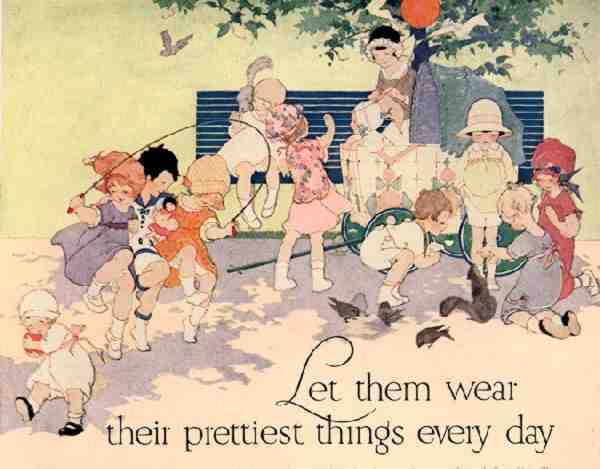
Lux Soap Advertisement, 1918

Figure 1.--This Lux ad shows both boys and girls with nice play clothes. Boys are shown wearing a sailor suit, a button-on shorts set, and a boy wearing a turned downed sailor hat, yellow smock and whire shirts. The shoes are indistinct, but the children are all wearing white socks.
|
Soap companies were major advertisers in the 1910s and Lux was one of the principal companies.Lux Soap in 1918 had colored advertisments which were quite expensive at the time. Quite a variety of clothes for younger children were picturde. While idealized, these were children's clothes that were worn in the 1910s. The idea behind the ads were to show what a goo job Lux when do wasing dat. Thus it would not have made sence to depicr clothes that were made up. Tus wile iealized, these were depictions of actual styles. The a copy mentions a boys' dress and one boy is pictured in a yellow smock with smocking. The new turnes-down style of sailor hats can also be seen.
Ad Copy
The ad headline reads, "Let them wear their pertiest things every day." It is rather a long ad, but some of the text is interesting. Apparently some soaps in the 1910s were quite harsh and would have damaged fine clothes. The ad reads, "Nowadays, even for play, you can let the children wear things that make them look and feel like faries--sweaters and frocks of light pinks, blues and tans, even of white--scalloped flannel petticoats, little silk hoods." Further on it quotes a mother, "His soft woolens never shrunk a shread--never stiffened or grew yellow--not even after repeated washings. And his darling little dresses were as dainty and fresh as new. Now that I have more children, I still let them wear dainty things. I keep their finest things like new with Lux."
Product
One rarely sees a Lux add today. Lux soap in the 1920s, however, was heavily advertised. After World War I in the 1920s even color advertisements appeared in magazines. They were still unusual and speak of an expensive advertising campaign. Interestingly the same Lux soap was used for dishes, laundry, babies' milk bottles, linoleum, paint, porcelin, rugs, and shampoo. I find it interesting thatthe same product was used for rugs and shampoo. It should be remberedm however, that as late as the 1900 there was no laundry soap to help housewives do the family laundry which would required an entire day of work. Affluent familes had domestic staff. Mothers in less affluent familes would need help from their daughters wjo might even have to stay home from school.
Clothing
Some interesting aspects of the boys clothing include the following:
Sailor hat
The boy in the yellow hat wears a turned down sailor hat. This is essentially a wide-brimmed sailor hat with the brim turned down. We ave noticed this style in 1910s images.
Dresses
Te ad copy mention's a boy's dresses. By the late 1910s this was becoming less common. The boys in the ad do not appear to be wearing dresses. Perhaps they were referring to the infant at the lower left.
Frocks
All the girls appear to be wearing colorful frocks.

Figure 2.--The child in the yellow smock is clearly a boy. Girls in the 1910s did not wear short pants.
|
Smocks
Only one child is wearing a smock. It is a yellow smock with decorative smocking. As he wears white shorts underneath, presumably he is a boy. HBC is not sure how common smocks were for boys in the 1910s. This one appears to have a front opening with drawstrings. It is worn without a belt.
Sailor suits
One boy wears a blue and white short pants sailor suit. As he is wedged between two girls it is hard to get a good look at his suit.
Socks
All of the children wear white short or three-quarters socks. The boy in the sailor suit has blue tops to his socks.
Shoes
The shoes are not destinguishable.
Ad Analysis
One interesting aspect of this drawing is how differently the boys and girls are dressed in 1918. Some boys at this ageat the turn-of-the century migt have been dressed much alike. Also notice the comfortable unresrictive styles. Children's clothes at the turn-of the-century was much more formal. Choldren wore heavier more restrictive styles.
An HBC reader comments, "Let us never forget that ads sell dreams and magic. Soap ads especially promise vast amounts of beauty
and happiness as a result of laundering. But even the catalog pages, which have more straight-forward information, sell a mother the hope that her son will look and behave a certain way if she puts him in certain clothes. As to whether it reflects any kind of reality--giving us an
idea of how many boys wore Fauntelroy suits, that is an interesting question."
Christopher Wagner

Navigate the Boys' Historical Clothing Web Site:
[Return to the Main advertisement page]
[Return to the U.S. early 20th century smock page]
[Introduction]
[Activities]
[Bibliographies]
[Biographies]
[Chronology]
[Clothing styles]
[Countries]
[Essay]
[Literary]
[Boys' Clothing Home]
Created: May 6, 2001
Last updated: May 7, 2001




